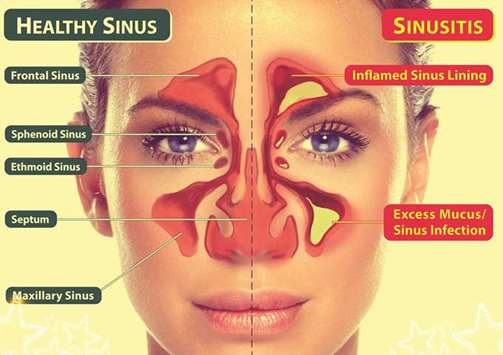With winter just around the corner, cold weather related illnesses, like sinus infection, better known as sinusitis, are making a return. An infection of sinus, also called, as sinusitis is very common among people of all ages. It is medically called rhinosinusitis. It is a condition that hits you when your nasal cavities are infected.
The Latin origin word “sinus” means a cavity within a bone or other tissue. Many such air containing cavities are located between the eyes and on the either side of the nose. They are connected to the nose and get their ventilation from the nose. They are lined by a self-cleaning and defensive membrane. Normally they are empty and contain a little amount of mucus and no fluid. The exact functions of these sinuses are debatable and they don’t have any specific function. The word “sinus” is commonly used for problems related to cold and headaches.
Why the problem?
During a common cold the sinuses also get infected and normally get cleared in about 7-10 days. But if the drainage passages of the sinuses get blocked due to problems like deviation of the nose bridge, polyps, nasal allergy, dry dusty conditions or dehydration, the mucus drainage gets affected, leading on to collection of mucus and infection. That gives rise to pain on the face, eyes or head.
How to suspect?
Most patients with fresh sinus infections complain of pain or pressure over the cheeks, face, teeth or around the eyes or a headache following a history of a cold. There could be dribbling of mucus from the back of the throat, blocked nose, fever and cough.
Those with long standing sinus infections complain of frequent nose blocks, dribbling of mucus from the back of nose, heaviness of head, eyes and a persisting cough. Remember that sinus disease can present without any pain or headache also! In children, it may present as frequent headaches, puffy lids, lack of energy or concentration, ear aches or ear blocks, constant sniffing and cough. Frequent and persisting cold beyond 10 days could also be due to sinus disease.
How it’s detected?
Specialist consultation is advised. Detailed examination of the nose and simple painless techniques like sinus X-rays or CT scan and nasal endoscopy are used to detect subtle abnormalities of the nose which block the sinus drainage. It helps in the diagnosis and staging of the sinus disease. Additional blood tests for diabetes and allergy help doctors to provide appropriate treatment.
What is the treatment?
Fresh sinus infections are treated medically with nasal sprays, painkillers, medicines that thin out the mucus and antibiotics, when needed. Home remedies like steam inhalation, warm food and plenty of warm fluids and avoidance of dusty, dry, polluted locations will help in the mucus clearance from the infected sinuses. Smoking, diabetes, dehydration and nasal allergy delay the recovery and have to be taken care of. The duration of medical treatment may vary from 7-10 days. Noncompliance by the patient may lead on to a partial cure and low levels of sinus disease without pain, and they may think that they have been cured.
Repeated and low grade sinus infections destroy the defensive and the self-cleaning properties of the lining membrane present in the sinuses. This results in delayed mucus clearance, stagnation and infection. Long-standing sinus infections may require months of medical treatment.
Problems like deviations of the nose bridge and polyps further complicate or delay the recovery and may require surgical treatment. Doctors may advise to continue the medical treatment after surgery for a good recovery. It’s important to follow the doctor’s advice and follow up regularly.
Why treatment?
Sinuses are closely related to the eyes and neglected infections can spread to the eyes. Longstanding sinus obstruction and infections could encourage a fungal growth inside the sinus which is a difficult disease requiring prolonged treatment. With partial or incomplete treatment, the low grade infection continues and may act of as a reservoir for further sinus infections or in other parts of the body.
How to avoid?
* Most sinus infection following a common cold should resolve without any problems in around 7-10 days.
* Seek medical advice for a persisting cold or facial pain or headache.
* Complete the course of the medication and follow up to prevent low grade or long standing sinus infections.
* Keep nasal allergy and diabetes under control.
* Avoid exposure to dusty areas, extreme weather conditions during an attack of cold.
* Take plenty of warm fluids and steam inhalations.
* Stop smoking and avoid dehydration for an early recovery.
* Treat the sinus infections promptly and properly.
* Dr Ramesh Varadharajan, MBBS, DLO, MS (ENT), is a Specialist-ENT at Aster Medical Centre, Old Al Ghanim

GULF TIMES


